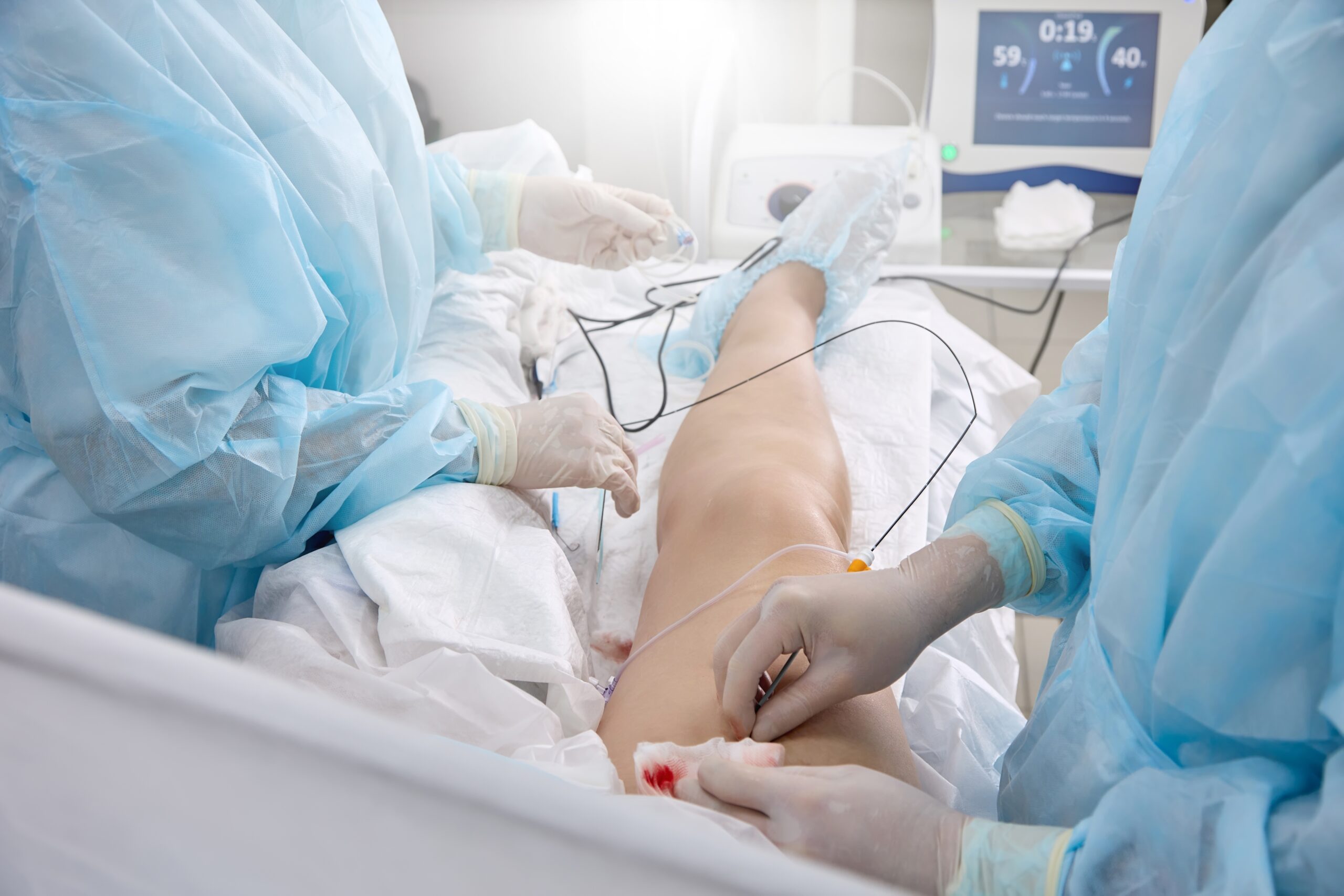The purpose of vein ablation treatment is to reduce discomfort and alleviate your symptoms so you can get back to living a healthy life. The procedure also reduces complications as a result. Treatment for venous insufficiency will depend on the severity or stage of the condition.
Some of the benefits of vein ablation treatment include the fact that it’s a minimally invasive procedure that doesn’t require any incisions or stitches. The procedure usually takes place as an outpatient, and patients are able to resume their normal activities within a few days of the procedure. Moreover, researchers have proven its long-term effectiveness and safety for the treatment of varicose veins.
You should not only discuss the benefits of ablation in leg veins with your doctor but also how this unique treatment is applied and what you can expect.
How Vein Ablation Treatment is Performed
A vein ablation treatment procedure involves inserting a thin, flexible tube into the affected vein. Using a laser or radiofrequency energy, doctors close off the vein. Eventually, the vein will collapse and disappear.
In essence, vessel ablation seals or closes veins using heat or laser energy. Using a small probe, radiofrequency ablation (RFA) can destroy veins — also known as ablation RFA.
The two main types of vein ablation treatment are radiofrequency ablation and laser ablation. In spite of the frustration associated with recurrent varicose veins, rates of recurrence are low with newer techniques, and patterns of recurrence are easily recognized. Clinical outcomes are excellent when physicians treat these new refluxing veins with multiple tools.
Sclerotherapy, phlebectomy, and saphenous ligation are other non-invasive and somewhat invasive techniques. Sclerotherapy involves injecting saline water, foam, or a chemical solution into the affected vein to harden it. Other veins grow around it to bypass the one that the body is no longer using, as a result. A phlebectomy involves a surgeon removing the damaged veins through small incisions made near the vein. Lastly, a saphenous ligation involves tying off and removing the affected vein, allowing other veins to fill in for it.
Post-Procedure Recovery: Vein Ablation Treatment
Depending on the extent of the vein ablation treatment procedure, doctors use different types of anesthesia. For small varicose veins, local anesthesia is often used to numb the area around the vein. Patients with larger varicose veins or anxious about the procedure may require general anesthesia, which puts them to sleep. However, most doctors usually recommend non-invasive local anesthesia for a smooth procedure and healthy recovery period.
In the recovery room, the patient will rest after the procedure. They will need to wear compression stockings for several weeks afterward to prevent blood clots.
After the procedure, patients may experience some bruising and swelling, but these side effects usually disappear within a few weeks. After deep vein ablation surgery, varicose veins may recur. Overweight or obese patients are more likely to develop varicose veins if they have a family history of them.
In most cases, procedures are accomplished in a clinic or on a day-case basis. Overnight stays are rare. To reduce bruising and promote healing, doctors firmly apply bandages to your leg (or legs). It’s possible to replace the bandage with a stocking after a couple of days and wear it for up to one week. Wearing the stocking day and night may be easier during the first few days. You can then wear the stocking only during the day if the leg feels comfortable without it at night. Get up and move around your house, or even outside in a yard or garden, either laying with the leg elevated or elevating the ankle. Stand up slowly and avoid crossing your legs for an extended period of time. Many patients find they can walk at least a mile, if not more, every day during the recovery process.
After Treatment
It’s possible for the treated deeper vein to become sore within three to five days after your vein ablation treatment procedure. Treatment reactions like this will settle in time as a result of the treatment. For a few days, anti-inflammatory painkillers can ease the discomfort. Instead of stitches, skin glue or tape is usually used to close small cuts on the leg after a phlebectomy. In most cases, stitches can be dissolvable.
It can take up to four days to recover from ablation RFA or endovascular ablation (without any phlebectomies). However, a phlebectomy, which uses a small scalpel or needle to remove varicose veins, would also unavoidably result in some discomfort and bruising. As a result of vein removal, the severity varies.
In most all cases, the soreness will subside within five days or shorter, but it will take a while for the bruising to completely disappear. You can reduce this bruising by keeping mobile after the procedure and wearing the provided stockings. It’s rare for wounds that are this small to become infected.
Untreated Varicose Veins and Vein Ablation Treatment
Untreated blood circulation, venous disorders, and varicose veins can lead to even more pain — putting vein ablation treatment on your radar. Leg pain and heaviness are common symptoms of varicose veins, especially after prolonged standing. The pain, itching, and other symptoms of varicose veins can get worse over time, since varicose veins often progress.
Other Conditions to Look out for
Not treating your issues and avoiding ablation in your leg veins can lead to the following conditions:
- The presence of edema. A varicose vein causes liquid (water and protein) to leak into nearby tissues, due to the added pressure within the vein.
- There is a condition known as superficial thrombophlebitis (STP). Varicose veins often lead to phlebitis, an inflammation of the vein walls. Inflammatory superficial veins form clots directly under the skin, which can cause a red-hot hard knot under the skin.
- The most common type of thrombosis is deep vein thrombosis (DVT). The symptoms of DVT are caused by blood clots forming in deep veins of the leg. Symptoms include leg pain, swelling, redness, and tightness.
- You should seek medical attention or vein ablation treatment as soon as possible if you have DVT.
- The condition of stasis dermatitis. As a result of prolonged saphenous vein reflux, stasis dermatitis occurs. When it first appears on the inside of the ankles, it can progress to turn the entire ankle and lower leg red and brown.
- Ulceration on the skin. The majority of venous ulcers occur around the ankles, where they simply do not heal. The brown and red skin color changes caused by stasis dermatitis result from long-term superficial venous insufficiency (improper functioning valves in the veins).
The United States is experiencing a major problem of Chronic Venous Insufficiency (CVI). Approximately 5 percent of all Americans have some changes associated with CVI. Adults with varicosities are estimated to have 5 to nearly 60 percent of them, with 35 to 45 percent of them experiencing clinical varicose reflux. Venous stasis ulcers affect about 500,000 people. A 92-per-hundred-admission rate for CVI is the average.
Tips for Dealing with Vein Pain at Home
For some individuals, vein ablation treatment is in sight but might be days or weeks away. The following are some steps you can take right now if you are suffering from venous insufficiency so you can manage the symptoms or slow its progression:
- Dress loosely and avoid wearing high heels.
- Keep your blood pressure under control by seeing a doctor regularly.
- Keep an eye out for ulcer symptoms on your skin every day.
- Maintain a daily skin-moisturizing routine.
- Ensure that your diet is balanced, and do not exceed the daily salt or sodium recommendations.
- Maintain a regular exercise schedule throughout the week.
- You should avoid long periods of sitting or standing. Move around regularly during breaks.
- Keep your legs elevated periodically throughout the day. Make it a routine to do so.
- Keep your weight moderate.
- With your doctor’s guidance, wear compression stockings or wraps to improve blood flow.
It’s easy to become disabled and for your venous insufficiency to worsen without having deep vein ablation. You may require clinical vein ablation treatment for several years in such cases. Even with ablation in leg veins, people can experience complications. Consult your doctor or health specialist first.
Wellness and Pain
When it comes to vein ablation treatment, you’re better off knowing all the facts up front and seeing a doctor who truly cares about you and your health. A quick evaluation may include a blood flow and circulation ultrasound test for vascular disease, or another simple test.
Practitioners at Wellness and Pain confidently provide these important evaluations, apply their professional expertise, and offer the caring and sensitive vein ablation treatment you need to improve and eliminate any symptoms you are experiencing.











